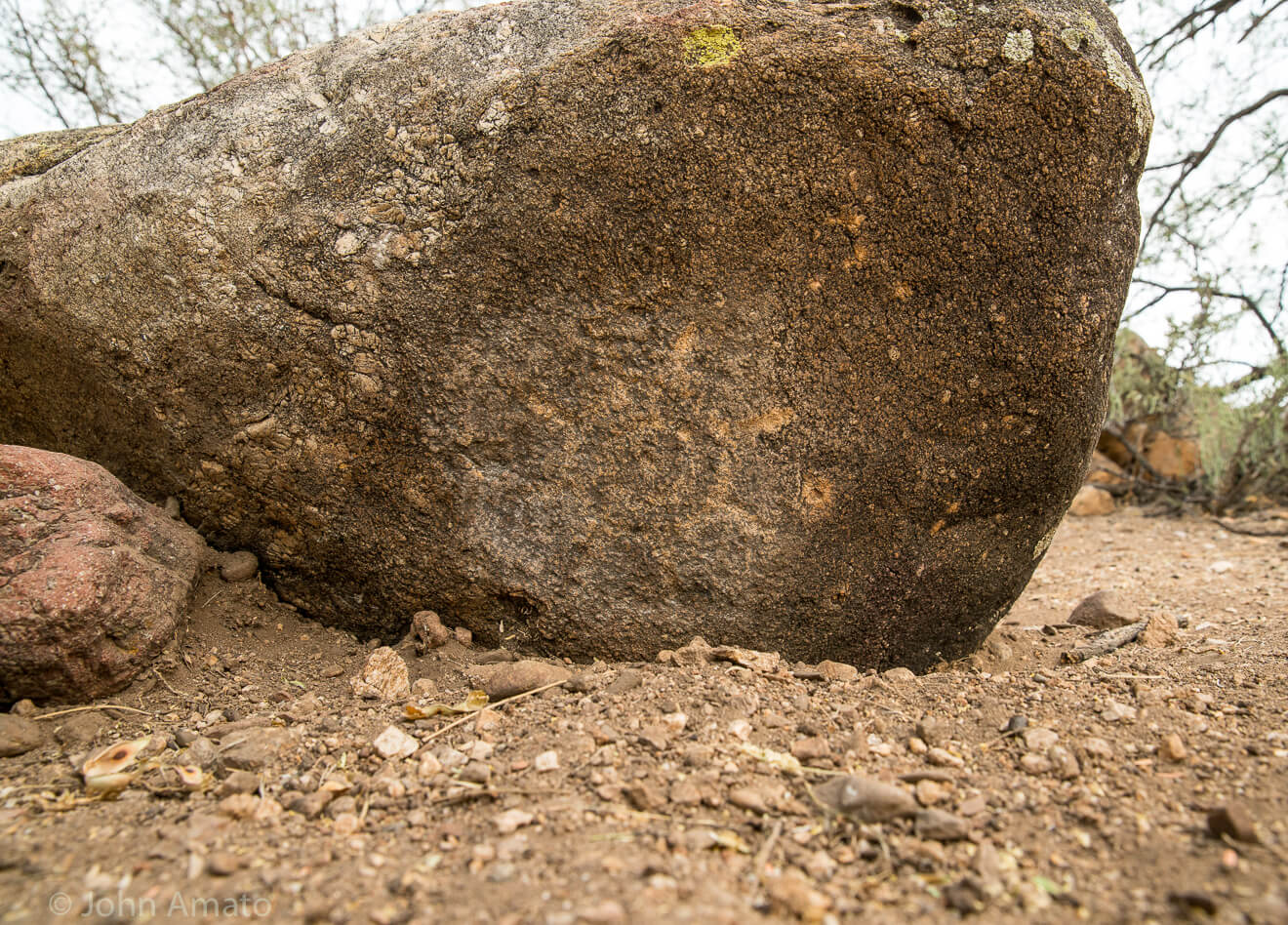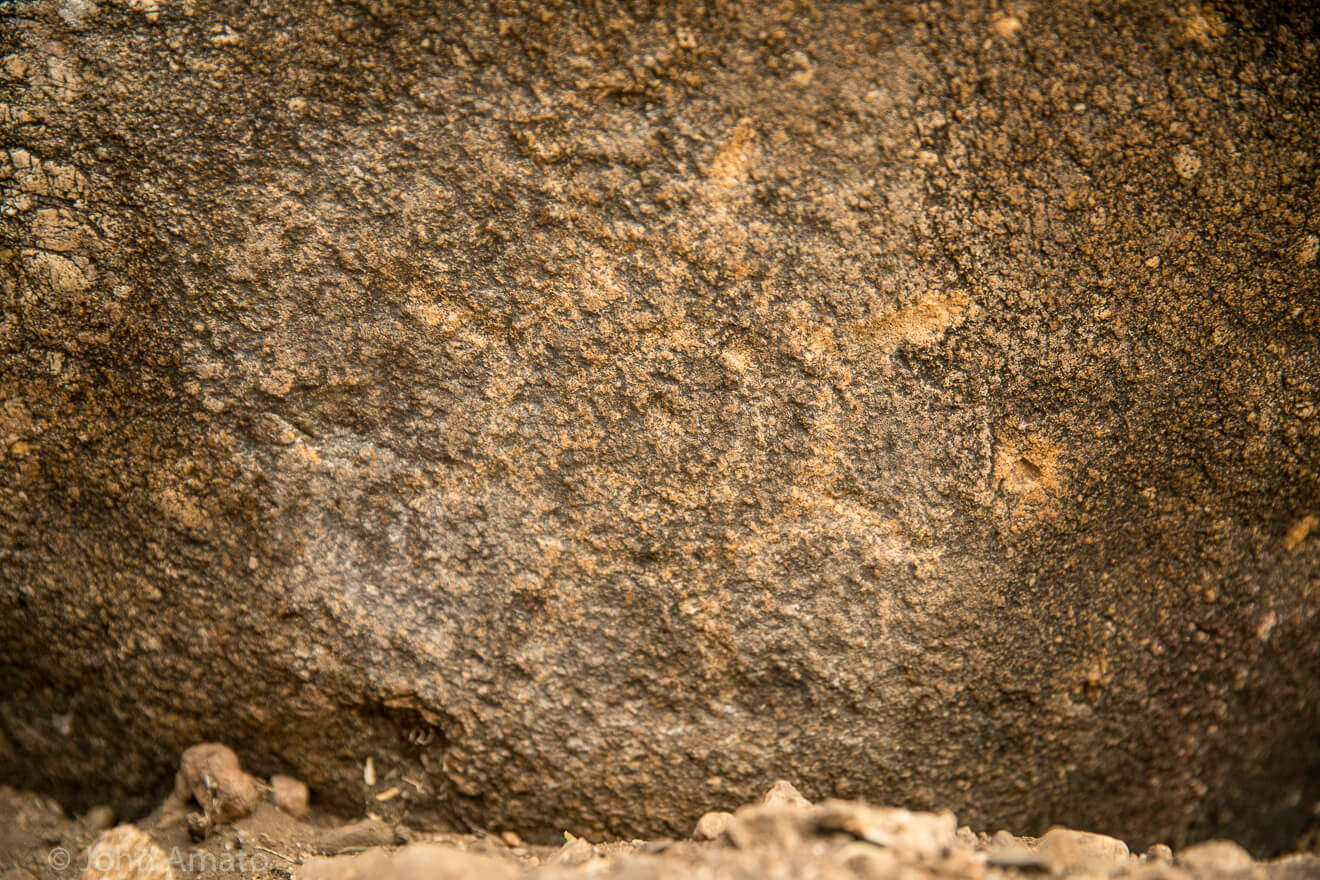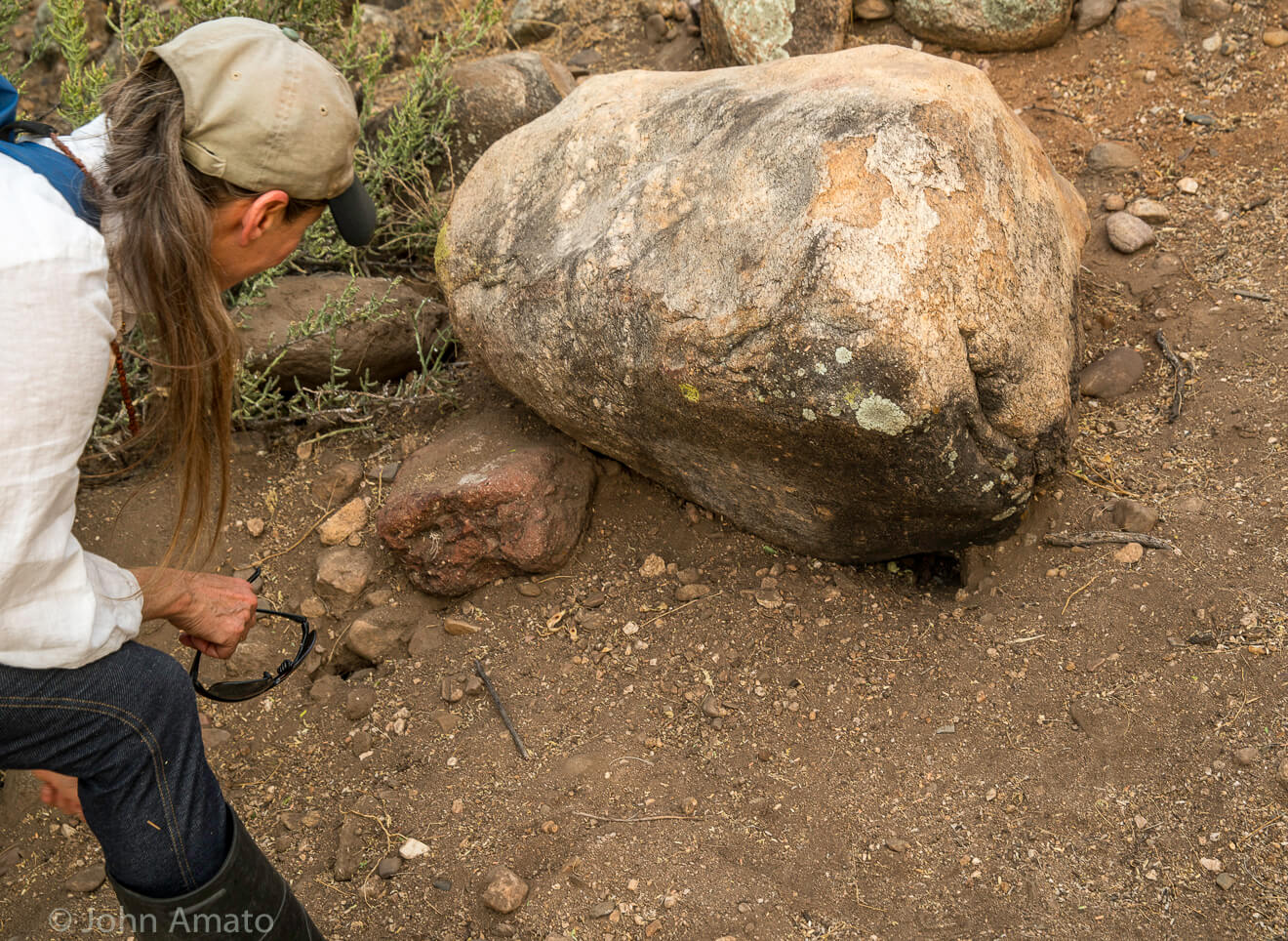
In January 2016, a several hundred pound boulder with a magnificent Tohono O’odham sunburst petroglyph was toppled in the Coronado National Forest adjacent to Catalina State Park.
As an Arizona steward with the privilege and honor of living and working in the Tohono O’odham Haki:dag (the Tohono O’odham Homeland of occupied Tucson in the Catalina Mountains of the Sonoran Desert), I contacted the Tohono O’odham Nation Cultural Resource Preservation Officers, The US Forest Service and Catalina State Park Rangers to offer assistance with the restoration.
A misguided archaeologist with the US Forest Service told me that, “The Tohono O’odham Nation does not have jurisdiction over this land.”
There must be government to government consultation according to the UN Declaration on the Rights of Indigenous Peoples.

Dr. Bill Doelle’s close-up image of the sunburst petroglyph prior to vandalism
In June 2017, I was awarded a scholarship to attend the Arizona State Historic Preservation Conference where I had the pleasure and honor of meeting the Vice Chair of the Tohono O’odham Nation, Verlon Jose, who was presenting at the conference. He asked us all to protect every twig and rock in the Tohono O’odham homeland. After his presentation, I talked with Vice Chair Jose about the toppled boulder and his Peoples’ petroglyph that was lying face down in the dirt for many months. I told him of the disrespectful, disturbing and ignorant statement of the US Forest Service archaeologist.
Vice Chair Jose expressed an interest in visiting the site. He also indicated that the archaeologist’s statement was incorrect; the Tohono O’odham Nation certainly does have jurisdiction over this land.
That same month, I revisited the petroglyph boulder and found that it had been moved, revealing an unidentified white substance that was smeared on the petroglyph. I filed an Activity Report of Vandalism, as I was unaware of any restoration efforts undertaken by the US Forest Service and Catalina State Park.
I contacted Dr. Nancy Odegaard, expert Conservator at The University of Arizona State Museum with my concerns about the vandalism of the petroglyph boulder. We discussed visiting the petroglyph to investigate its condition so that Dr. Odegaard could offer suggestions for the prudent removal of the unidentified white substance (perhaps paint) that was believed to have been smeared on the petroglyph by vandals and later wiped with a dry cloth by a US Forest Service archaeologist during the partial restoration.

Photo taken by John Amato on September 21, 2017 after the partial restoration by the US Forest Service and Catalina State Park personnel
The US Forest Service lacks the professional conservator expertise to properly deal with these issues.
Images sent to Dr. Odegaard revealed that the boulder was rolled over down the slope of a flat-topped ridge and pivoted slightly so that the petroglyph was face down in the soil. In the spring of 2017, the boulder was partially rolled back by State Park personnel, only part-way, to reveal the petroglyph, as the US Forest Service and State Park personnel indicated that they lacked the human power to restore the large boulder and petroglyph to its original position. Efforts to formally close and block the trail had been undertaken prior to the vandalism and regular monitoring by stewards, park and forest personnel had been increased.
Of primary concern was the unidentified white substance on the surface area of the petroglyph. Was it a product of a poor cleaning attempt during the restoration and was it causing further damage to the petroglyph?

Photo taken by John Amato on September 21, 2017 after the partial restoration by the US Forest Service and Catalina State Park personnel
Dr. Odegaard was glad to assist as a professional Conservator with experience in rock art damage remediation, however she indicated that it is not her primary specialty. It is important to note that professional conservators never take actions to treat things without approval of its owner or custodian. Therefore in this case, Dr. Odegaard did not want to visit the site or propose any activities without the involvement of the National Forest Service. This is the cultural property of the Tohono O’odham Nation.
Dr. Odegaard’s schedule permitted a visit to take place on September 27, 2017. With the approval of a US Forest Service archaeologist, a visit was planned. Jonathan, the State Park Ranger working that day, escorted her to the petroglyph and answered her questions.
We provided Dr. Odegaard with before vandalism and after partial restoration images of the petroglyph boulder by Dr. Bill Doelle and John Amato.
Dr. Odegaard’s assessment, based on her understanding of what she had been told and what she had seen is that it is possible that additional pecking and abrasions to the petroglyph surface may have been added by the vandals.
The white substance on the petroglyph does not appear to be paint—neither visually or by FTIR analysis. FTIR Analysis, also known as FTIR Spectroscopy is an infrared spectroscopy method used to identify organic, polymeric, and in some cases, inorganic materials. The FTIR test uses infrared light to scan test samples and observe chemical properties.
Soils contain billions of bacteria, fungi and other living organisms. As they grow, they produce byproducts that create spaces between the soil particles and allow air and moisture in. A buildup of white fungus typically indicates excess moisture.
Dr. Odegaard stated that it seems likely that when the petroglyph was down in the soil for many months, moisture allowed fungi to thrive at the petroglyph surface, especially if any protective desert varnish was removed by vandalism.
After partially re-positioning the boulder, the area at the petroglyph was exposed to the air and began to dry therefore it is believed that the fungus is dying out….
When Dr. Odegaard applied water and alcohol on a swab to see how the white substance would react, she noticed that the white appearance diminished. She added that perhaps time alone would take care of the white substance. Sadly, there is no way to reverse the newer abrasions to the surface of the boulder as a result of vandalism. Dr. Odegaard concluded that she thought no further human intervention is necessary at this time.
Unfortunately, the boulder with its once pristine sunburst petroglyph is not in its pre-vandalism original position, however the petroglyph is more obscured from visitors as it is approximately only two inches above the soil surface.
We must monitor this Tohono O’odham creation in the event of rain that could once again impact and bury the petroglyph in the soil.

Photo taken by John Amato on September 21, 2017 after the partial restoration by the US Forest Service and Catalina State Park personnel

Indigenous Peoples are putting their bodies on the line and it's our responsibility to make sure you know why. That takes time, expertise and resources - and we're up against a constant tide of misinformation and distorted coverage. By supporting IC you're empowering the kind of journalism we need, at the moment we need it most.